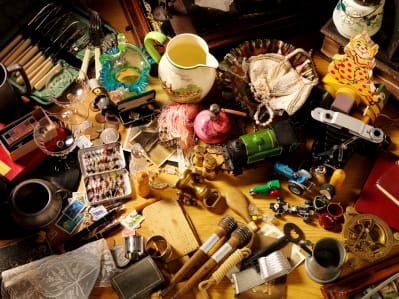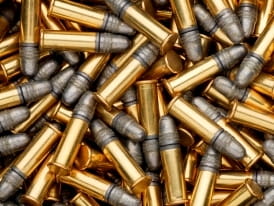Unusual Sources of Lead Poisoning

The Bottom Line
At one time, the usual sources of lead poisoning were lead paint and leaded gasoline. Now, more unusual sources of lead poisoning include jewelry, cosmetics, imported herbal and traditional medicines, and even hobby supplies. Lead poisoning damages the nervous system but the symptoms can be misleading. Lead poisoning can only be diagnosed with a blood test.

The Full Story
Children still suffer from lead poisoning, even though leaded house paint and leaded gasoline are no longer sold. Unusual sources of lead can cause effects ranging from mild abdominal symptoms to seizures, coma, and death. Children with lead poisoning may have lower IQ scores, difficulty with reading and math, and such behavior issues as attention deficit disorders and delinquency.
In recent years, lead poisoning in the U.S. has been caused by a variety of items.
- Jewelry and cosmetics. Children's jewelry containing lead has caused lead poisoning and even death. Some imported cosmetics have been contaminated with lead; examples include kohl, used as eye liner, and sindoor, a red powder used on the scalp by married Hindi women.
- Imported medicines, traditional medicines, and folk remedies. For example, azarcon and greta are used to treat empacho (stomach symptoms); both contain a substantial amount of lead. Many herbal medicines from India (64% in one study) contain lead. Lead has been found in folk remedies for arthritis, infertility, cramps, and colic. Contaminated medicines have been imported from many countries. In some cases, they were purchased overseas and brought into the U.S. by consumers.
- Imported foods and candies. Tamarind candy and candy wrappers from Mexico were contaminated with lead. A number of spices and food products imported from India were contaminated with lead. These problems were found when children exposed to them were treated for lead poisoning.
- Bullets, lead pellets, and hobby items. Licking bullets, swallowing lead pellets or shot, or breathing fumes from melted lead for fishing weights have caused lead poisoning. A pregnant woman and her infant both had lead poisoning from a bullet in the mother’s spine (she had been shot fifteen years earlier).
- Home items. Children have had lead poisoning when acidic foods were stored or served on imported ceramic dishware and pitchers. Lead poisoning has resulted from contaminated plastic mini-blinds. Curtain weights may contain lead. Antique cribs and furniture may be sources of lead-based paint.
Whatever the source, lead poisoning is dangerous for children. Our bodies don't need lead; there is no "normal" lead level in our blood. Lead damages the nervous system, especially in young children.
Symptoms of lead poisoning can be vague: stomach pain, fussiness, trouble concentrating, and loss of appetite could be due to many things besides lead. Lead poisoning is diagnosed with a blood test. There are treatments, but there is no substitute for prevention.
- Do not use imported ceramic plates, pitchers, etc. to store or serve food. Use them for decoration only.
- Many plastic mini-blinds have been recalled because of lead dust. If yours are old, consider replacing them.
- Do not purchase inexpensive metal jewelry for children. Many types have been recalled because of high amounts of lead; some substitutes have contained the toxic metal cadmium.
- Prevent children from licking or sucking on hobby materials that could contain lead: bullets, pellets, fishing sinkers.
- Be certain of the source and safety of imported cosmetics and medicines, especially traditional and folk medicines. Many contain heavy metals, including lead.
If you think that you or someone else may have lead poisoning, your doctor can do a blood test to find out. This is the only way to diagnose lead poisoning.
If you have questions about lead or the treatment of lead poisoning, call 1-800-222-1222. Poison specialists will answer your phone call 24 hours a day.
Rose Ann Gould Soloway, RN, BSN, MSEd, DABAT emerita
Clinical Toxicologist
Poisoned?
CALL 1-800-222-1222
Prevention Tips
- Do not use imported ceramic plates, pitchers, etc. to store or serve food. Use them for decoration only.
- Many plastic mini-blinds have been recalled because of lead dust. If yours are old, consider replacing them.
- Do not purchase inexpensive metal jewelry for children. Many types have been recalled because of high amounts of lead; some substitutes have contained the toxic metal cadmium.
- Prevent children from licking or sucking on hobby materials that could contain lead: bullets, pellets, fishing sinkers.
- Be certain of the source and safety of imported cosmetics and medicines, especially traditional and folk medicines. Many contain heavy metals, including lead.
This Really Happened
Case 1: A 4-year-old boy was diagnosed with viral gastroenteritis because of vomiting. Two days later, he was vomiting continuously and was listless and dehydrated. In the emergency room, he was given fluids, then admitted to the hospital. About ten hours later, he became agitated, stopped breathing, and was resuscitated. On x-ray, a heart-shaped foreign body was seen in his stomach so a blood lead level was requested. It was extremely elevated. Soon after, the child suffered severe brain damage and died. On autopsy, a metal charm that came with a pair of shoes was found in his stomach. His mother had no idea he had swallowed the charm.
Case 2: An 11-month-old child was found to have an elevated blood lead level on routine screening. A home evaluation revealed no obvious source of lead exposure. The parents divulged that they had been applying "surma" to the child’s eyes every day for 5 months to "strengthen them". Surma is a fine powder that looks like mascara. It is applied to the inside of the eyelid for cosmetic or medicinal purposes in many Asian countries. The child’s grandmother had brought the surma from India. Testing of the powder revealed it to be 25% lead by weight. The parents stopped applying the substance to the child’s eyes. Within 8 weeks the child’s blood lead level had dropped substantially.
For More Information
References
Bellinger DC. Very low lead exposures and children’s neurodevelopment. Curr Opin Pediatr. 2008;20:172-177.
Gorospe EC, Gerstenberger SL. Atypical sources of childhood lead poisoning in the United States: a systematic review from 1996-2006. Clinical Toxicology. 2008;46:728-737.
Lin CG, Schaider LA, Brabander DJ, Woolf AD. Pediatric lead exposure from imported Indian spices and cultural powders. Pediatrics. 2010;125:8828-e835.
Raymond LW. Maternal-fetal lead poisoning from an old slug: 10-year follow-up. J Maternal-Fetal and Neonatal Med. 2009;22:543-544.
Sharmer L, Shackley MS, Harding AK. A potential new health risk from lead in used consumer products purchased in the United States. J Env Health. 2010;73:8-12.
Poisoned?
CALL 1-800-222-1222
Prevention Tips
- Do not use imported ceramic plates, pitchers, etc. to store or serve food. Use them for decoration only.
- Many plastic mini-blinds have been recalled because of lead dust. If yours are old, consider replacing them.
- Do not purchase inexpensive metal jewelry for children. Many types have been recalled because of high amounts of lead; some substitutes have contained the toxic metal cadmium.
- Prevent children from licking or sucking on hobby materials that could contain lead: bullets, pellets, fishing sinkers.
- Be certain of the source and safety of imported cosmetics and medicines, especially traditional and folk medicines. Many contain heavy metals, including lead.
This Really Happened
Case 1: A 4-year-old boy was diagnosed with viral gastroenteritis because of vomiting. Two days later, he was vomiting continuously and was listless and dehydrated. In the emergency room, he was given fluids, then admitted to the hospital. About ten hours later, he became agitated, stopped breathing, and was resuscitated. On x-ray, a heart-shaped foreign body was seen in his stomach so a blood lead level was requested. It was extremely elevated. Soon after, the child suffered severe brain damage and died. On autopsy, a metal charm that came with a pair of shoes was found in his stomach. His mother had no idea he had swallowed the charm.
Case 2: An 11-month-old child was found to have an elevated blood lead level on routine screening. A home evaluation revealed no obvious source of lead exposure. The parents divulged that they had been applying "surma" to the child’s eyes every day for 5 months to "strengthen them". Surma is a fine powder that looks like mascara. It is applied to the inside of the eyelid for cosmetic or medicinal purposes in many Asian countries. The child’s grandmother had brought the surma from India. Testing of the powder revealed it to be 25% lead by weight. The parents stopped applying the substance to the child’s eyes. Within 8 weeks the child’s blood lead level had dropped substantially.
